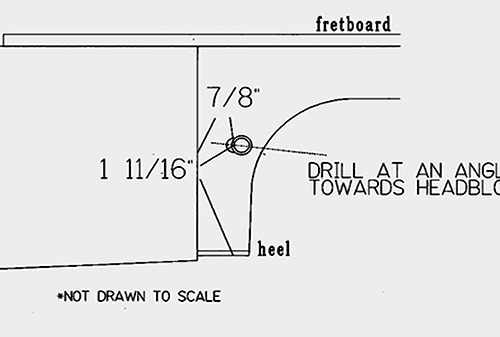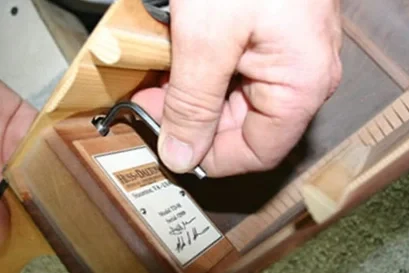Your Huss & Dalton instrument will last for generations following these simple care suggestions. If you have any questions/concerns, please send us a note using our contact page.
Temperature
You should try to keep your instrument between 40 and 95 degrees Fahrenheit, roughly. At least as important as temperature extremes, are temperature fluctuations. Whenever your guitar has been colder than usual, you should leave the guitar in the case and slowly bring it back to room temperature. Never leave your guitar in your car without temperature control. Your musical instruments are most comfortable in the same temperatures and humidity that you are!
Humidity
Your instrument should be kept in a humidity range of 45% to around 65%. You can monitor the humidity inside your case by using a small, inexpensive hygrometer. We supply all new guitars with a Boveda large starter pack and is our recommended source year round. You may purchase the kit and refills here: Boveda
If you keep your guitar out of the case on a stand, you will have to monitor and control the humidity in the whole room. Allowing the humidity to get too low in dry climates or with wintertime home heating can cause severe problems such as wood cracks and play ability issues. We recommend learning more about what product will work best for you and your environment. A small investment here can save a lot of money and trouble in the future.
Finish Care
Our finish on all instruments is a catalyzed urethane and needs little care. You should wipe it down with a clean, soft, damp cloth as needed. Then follow up with a soft dry cloth. Old t-shirts work great. We suggest Music Nomad’s Guitar Detailer
Whichever polish you use, make sure it is silicone free! Once a year or so, you may want to clean your fingerboard with 0000 steel wool. Then, rub some fingerboard oil into the fingerboard and bridge and recommend Music Nomad’s F-One Oil. Don’t overdo this part, but it is a good idea, especially in early fall, prior to the air getting dry.
Strings & Gauge
All Huss and Dalton Guitars are shipped with XT series D’Addario brand strings. Most larger body guitars ship with mediums, while smaller bodies ship with lights. All H&D guitars can be strung with light or medium strings except The Parlor, and OO / OO-SP models, which are braced for light gauge or lighter only. We also usually recommend that guitars with cedar tops be strung with light gauge strings.
Action
The action (string height) of your guitar should be around 6- to 7/64ths of an inch under the low “E” string at the 12th fret. (Measure from top of 12th fret to bottom of string) and around 5/64ths on the high “E” string. You may want to have lower action than this, and that’s fine, but keep in mind the playability/buzz threshold that comes in somewhere just under these measurements. If you are not experienced with adjusting the action of a guitar, any action adjustment should be made by a qualified repair person, or here at the H&D shop. THE TRUSSROD IS NOT AN ACTION ADJUSTER!! The Trussrod adjusts relief in the neck…although it does change the height of the action this is NOT how you adjust action height and instead is just a part of the tools to make a guitar setup.
Installing the Strap Button
We recommend taking your instrument to a reputable repair technician to install your strap button. This diagram should assist your technician in the placement of the button. Contact us if you have any questions.
Adjusting the Truss Rod (peg head access)
note: Our truss rod wrench measures 9/64″ pre-2024 (approx) and 4mm after 2024
You should know that we much prefer having truss rods adjust from the peghead. This allows you much easier access, and allows you to adjust the rod with the strings up-to-tension, which gives a better reading on where you need to be and where you are. However, some folks like the more traditional look of the body-access truss rod. We have never thought it was a good idea structurally to drill a hole in the upper face brace as is often done to gain access. So, it makes ours a bit more challenging to get the wrench seated properly. You should have received a 9/64″ or 4 mm Allen wrench with your H&D guitar.
Technical Specs: All Huss and Dalton Instruments have an adjustable truss rod. Some Models adjust from the peghead, while traditional series models and slotted peg heads adjust from inside the body. We set the relief at about .011 inch as the spec setup. To measure relief, put a capo on the strings at the first fret. With your left hand, push down the 3rd string at the 12th fret position. Now slide a .011 feeler gauge under the 3rd string at the 7th fret. You should feel a slight resistance, without the feeler gauge pushing the string up at all. If the rod needs adjustment, remove the truss rod cover on Standard H&D instruments, insert the Allen wrench provided and turn clockwise to tighten, counter-clockwise to loosen the rod. You may want the neck a bit flatter than .011, and that’s okay, but you will want some relief in the neck, and the neck should NEVER be back-bowed.
Contact us with any questions.
Adjusting the Truss Rod (body access)
Start by assessing the need to adjust in the first place. You can get the factory specs on the necessary relief from the Technical Specs section above. If you need to adjust, first loosen or remove the strings. You may, at this point, want to take a small mirror and a flashlight and look inside the guitar toward the nameplate and find the Allen screw in question. Now, reach inside with the Allen wrench and run you finger up the nameplate until it stops. Right above the nameplate, you’ll find the Allen screw. It may take a few tries, checking again with your mirror to see, but once you get used to it, you’ll be able to put the wrench right in place every time. There are also bent truss rod wrenches available in 4 mm sizing that you may be able to access the truss rod with the strings on through the soundhole. Some people find this method easier and some find it harder. We do not supply those wrenches but a quick search on the internet may find something suitable for you.
Shipping
Please contact us for return authorization prior to shipping any instrument to us.
We suggest following these steps to ensure safe travels:
Remove everything inside your case.
Include your complete contact information.
Loosen the tension on the strings.
Remove the pickup battery.
Remove the end-pin if it is not glued in.
Add additional packing surrounding under and over the peghead inside the case to offer more neck support.
Acquire a box in which the case can be packed tightly using packing materials. Your cased instrument should not ‘rattle’ around inside the shipping box.
Additional insurance is available for your instrument to cover the replacement value should something happen. UPS will only cover up to $100.00 as a default.
Very important: We DO NOT recommend mailing your instrument via the US Postal Service.


